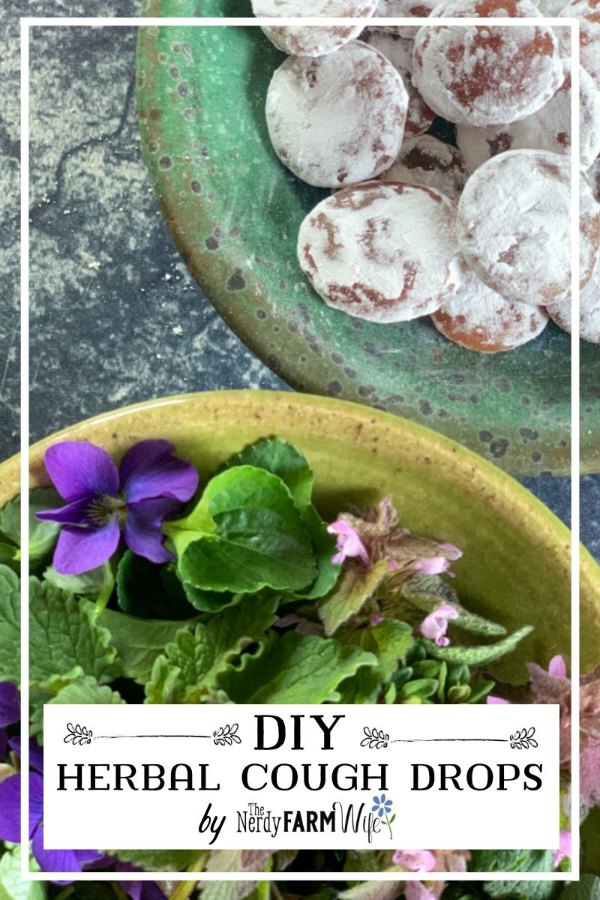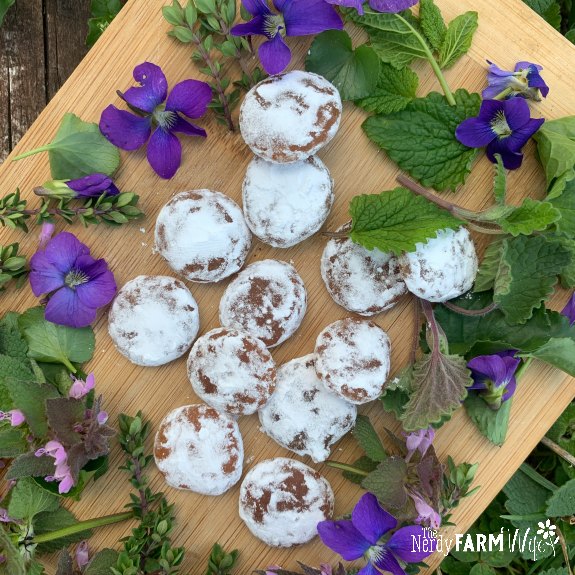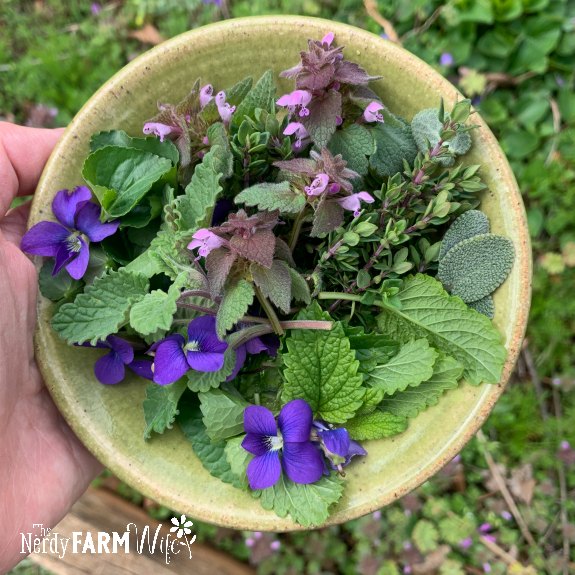Easy Simple Make Herb Cough Drops Diy Sugar
Learn how to make your own yummy antiviral herbal cough drops with this easy, customizable recipe using honey, sugar, herbal tea, and peppermint extract!

Recently, I made up a batch of this favorite cough drop recipe using beneficial plants and weeds growing around my house, plus a ton of antiviral extras thrown in, including several recommended tinctures from Stephen Buhner's herbal protocol.
Here in Spring 2020, we've been staying home for several weeks now to avoid the virus and prevent the spread, but my husband has needed to make a couple of grocery store runs.
I specifically made these drops to send with him to suck on while he was out, and to keep using after he got home. Every little antiviral thing we can do right now, we're doing!
They also make a really tasty treat when you want something sweet!
Some links on this site are affiliate links; I only recommend products I personally use and enjoy. As an Amazon Associate, I earn from qualifying purchases.

Recipe Notes
- You'll need an inexpensive candy thermometer, or infrared thermometer to keep tabs on the temperature.
- If you don't have a thermometer, you can use the cold water method of testing instead.
- The amounts of sugar and honey can be changed. You can use all honey, if you'd like to keep these sugar free, or you could use all sugar; just keep in mind the taste and texture will be a little different and honey scorches a lot more easily.
- Cough drops are meant to be sucked on, not chewed, and are not recommend for smaller children.
DIY Herbal Cough Drops
- 1 cup cane sugar (or honey)
- 1/2 cup honey
- 1/2 cup strong herbal tea (*see the options list below)
- 1/2 to 3/4 teaspoon peppermint extract (to taste)
- optional – 1 to 2 droppers of herbal tincture

Step 1 – Prepare the Herbal Tea
You can either make tea with your favorite packaged tea blend, or use a combination of herbs from the option guide listed below to make your own.
Place approximately 1/4 to 1/3 cup of chopped dried or fresh herbs in a mug or heatproof canning jar, using as much variety as you'd like.
Heat around 3/4 to 1 cup of water to almost boiling, then pour over the herbs in the mug or jar.
Cover with a saucer and let steep for at least 30 minutes, or longer for an even stronger tea. (I often steep mine for a few hours.)
Strain and measure out 1/2 cup of tea for the recipe.

Step 2 – Prepare the DIY Candy Molds
While the tea is infusing, add a few cups of powdered sugar to a 9 x 13 cake pan, or rimmed baking sheet. Using a small cap, measuring spoon, or your finger tip, make indentations in the sugar, as shown.
Tip: After using as a mold, the powdered sugar can be sifted to remove any small candy bits, and returned to its storage container.
If you don't wish to use DIY powdered sugar molds, lay out and prepare store bought candy molds and/or a large piece of parchment paper, spread over a baking sheet.
Step 3 – Combine and Cook the Ingredients
Add the tea to a heavy duty saucepan. Next, add the sugar and honey.
Turn the burner to medium or almost medium high heat and stir until the sugar has dissolved into the solution.
Next… you wait. Pull up a chair, read a magazine, work on the dishes, or do something nearby, just don't leave your candy unattended.
Every so often, check the temperature and give it a stir if it's looking a bit foamy (herbal tea sometimes does that) until the temperature reaches about 290 to 300 degrees F.
You can tell it's getting close when you notice a thicker consistency when stirred. The time it takes to reach this temperature will depend on the pan (thicker pans take longer), your climate and room temperature, and the heat of your burner.
It may take anywhere from 15 to 25 minutes, or even outside that time range, which is why keeping an eye on the temperature is most helpful.
If your mixture starts to smell like it's scorching at any time, you may be cooking at too high of heat or your pan might not be heavy-duty enough.
In order to save the batch from burning and becoming inedible, go ahead and pull it off of the burner.
When stored in the refrigerator, the cough drops will harden naturally from the cold, so the temperature isn't *as* crucial. They'll just be a little chewy instead of hard, if removed too soon from the heat – but still tasty!
Once the candy reaches around 290 to 300 degrees F, remove from heat and stir in the peppermint extract. Be careful, as it will cause a little flurry of extra bubbling!
Next, stir in herbal tinctures, if using.
Step 4 – Spoon or Pour into Molds
Working quickly as the candy will harden up FAST as it cools, carefully spoon or pour the hot mixture into the powdered sugar or candy molds.
I find it much easier to transfer to a Pyrex glass measuring cup pitcher first, before pouring.
If you're not using a mold, pour by the spoonful onto a sheet of parchment paper. (This is the messiest way!)
Let the candy sit, undisturbed, until cool. If using the powdered sugar method, lightly coat both sides with the sugar and store in single layers, between sheets of parchment or freezer paper.
You can keep them at room temperature for several days, or store in the refrigerator if they turned out chewy and need to be harder. If any are leftover after that, then I freeze them in single layers the freezer for future use.
If using 100% honey, these tend to store best in the freezer or fridge, from the start.

Herb Options List:
This is not an exhaustive list, but is a good place to start! As always, research each herb thoroughly before use. Some of these may not be a good fit for you if you're: pregnant, nursing, have health issues, or are on medication. Always check with a professional health care worker, when in doubt.
I buy most of the herbs that I don't grow from Mountain Rose Herbs or from small businesses on Etsy. You can also source herbs from your yard or garden!
- Astragalus: an adaptogen, excellent at restoring energy; helps you cope with illness or other stressors
- Bee Balm (Monarda): good for sore throat, congested coughs
- Catnip: helps insomnia and stomach distress
- Chamomile: soothes & relaxes; helps stomach aches
- Cinnamon: for flavor, warming, antimicrobial, good for digestion
- Cranberry: antibacterial; anti-asthmatic
- Dandelion: flower, leaf, root – detoxes; potential anti-cancer activity; kidney/liver support
- Echinacea: boosts your immune system
- Elderberry: excellent against influenza
- Forsythia Fruit or flowers: antiviral
- Ginger: powdered, dried or fresh – great for stomach aches/nausea; reduces inflammation; increases circulation
- Hawthorn: for heart health
- Lemon Balm: calming; relaxing; anti-viral; soothes stomach aches
- Marshmallow Root: soothes inflamed tissue; wonderful for sore throats
- Olive Leaf: antimicrobial
- Purple Dead Nettle: anti-inflammatory, may help allergies
- Roses: petals or leaves; anti-inflammatory
- Schisandra: another wonderful adaptogen; helps your body cope with stress and illness
- Thyme: for upper respiratory conditions, coughs & bronchitis; antiviral; antibacterial
- Valerian Root: helps you sleep, promotes relaxation
- Violet Leaf: soothing dry throats and coughs
- Yarrow: lowers fever, helpful for colds & indigestion
This article on making your own herbal cough drops was originally published in December, 2013, and updated for March, 2020.
Source: https://thenerdyfarmwife.com/diy-herbal-cough-drops/

0 Response to "Easy Simple Make Herb Cough Drops Diy Sugar"
Post a Comment